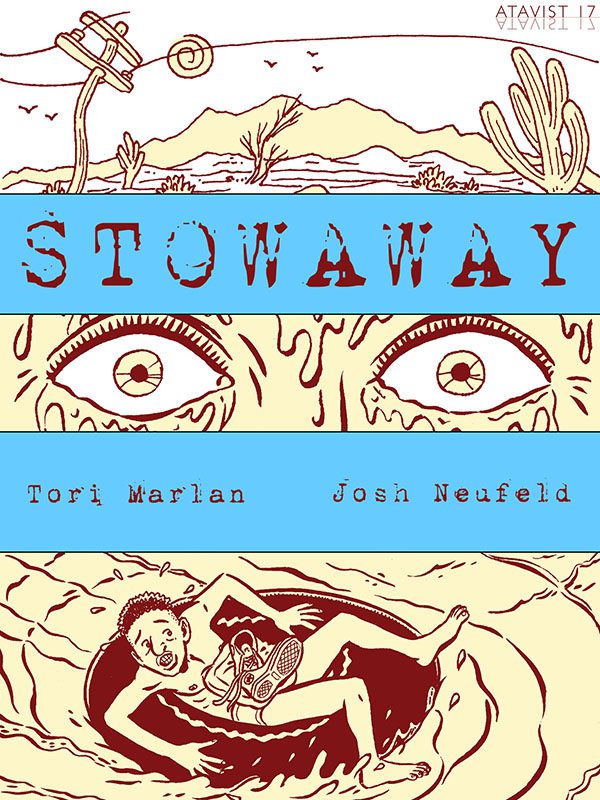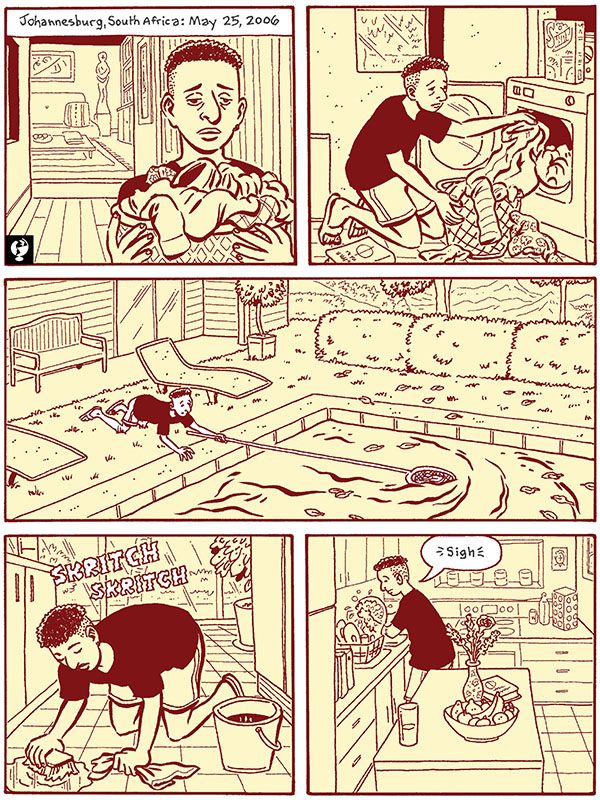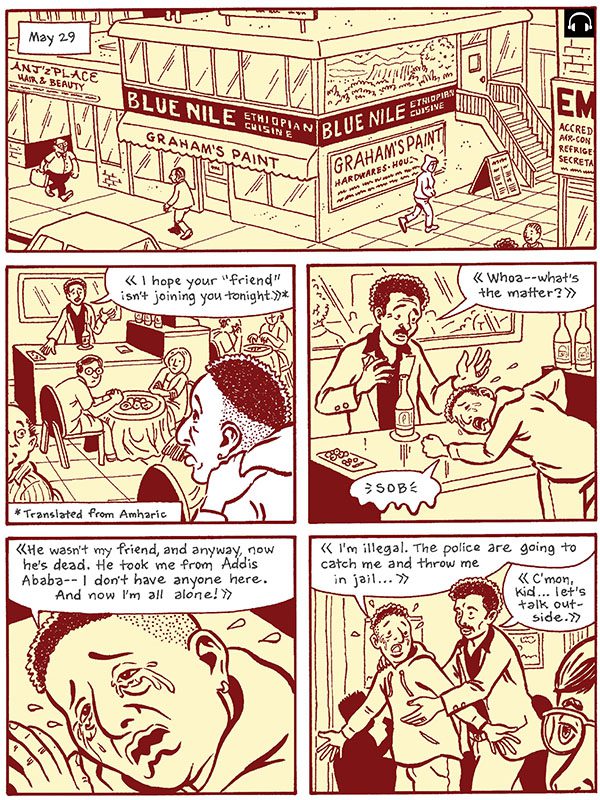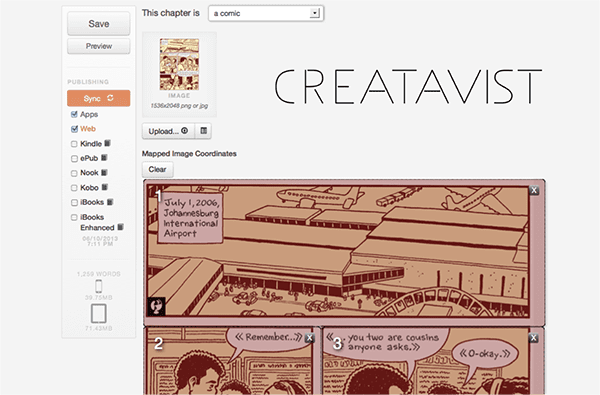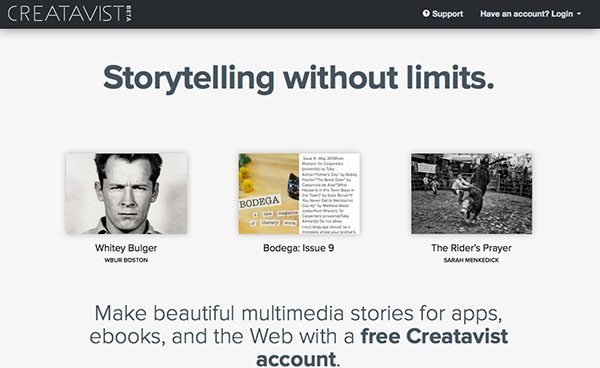The New York Comics & Picture-Story Symposium is a weekly forum for discussing the tradition and future of text/image work. Open to the public, it meets Monday nights from 7 to 9 PM in New York City. Presentations vary weekly and include everything from historical topics and technical demonstrations to creators presenting their work. Check out upcoming meetings here.
This week, the symposium was hosted by Bluestockings Bookstore and featured presenter Olivia Koski, senior producer at media and software company Atavist. The Atavist, the company’s flagship publication, is dedicated to the art of nonfiction storytelling. Over the past two and half years, they’ve published twenty-five new titles and worked on developing software solutions and creative tools for use by a wider community of storytellers.
The Atavist was founded as a way to explore longform journalism beyond the limitations of print- and web-based publications, which are always set within a strict grid. At the pace of about one title per month, each new digital book project is matched with the format that suits it best in order to bring the story to life and to maximize its potential. “Bringing a story to life” may be a counterintuitive expression in relation to virtual objects, but when published as an app, a book has access to more dimensions than conventional publishing formats and takes on any shape capable of expressing the individual story more authentically.
One of these dimensions is sound. While making Stowaway, The Atavist‘s first graphic-novel project, Koski worked closely with a compositor to create a unique soundtrack for each page. The book was written by journalist Tori Marlan and depicts the dangerous journey to America that Fanuel, a young Ethiopian orphan, bravely embarks upon in search of his only remaining friend. The images, by artist Josh Neufeld, along with the additional layers of sound, animation, dynamic paging, and interactive web-based content, transform Fanuel’s tale from a passive script to the portrait of a real person in a real place. Furthermore, the use of interactive content incorporates the reader’s presence into the story.
During the symposium, Koski demonstrated some of the features that were added to the story. Whenever a place is mentioned, the reader can click on a map icon and activate Google satellite technology to discover the protagonist’s location as seen from his/her perspective. In certain chapters, the reader can listen to the author and artist discuss their process and the research that went into a specific panel or layout. When making the book, Koski felt compelled to come up with features best suited for graphic storytelling. Compared to the scripts The Atavist has usually dealt with, this project, with an added layer of illustrated narrative, was already a multivalent reading experience. Koski showed us a panel of a restaurant Fanuel describes in his memories as the site of a smuggling operation. In a printed comic, the detailed image would be all the reader would need to be transported into Fanuel’s memory. Stowaway, however, is more than just Fanuel’s story.
It is enhanced by a behind-the-scenes glimpse of the research Marlan had put into finding said restaurant and directing that shot. What is at first read straightforwardly as a “snapshot” documentation of The Blue Nile Restaurant is in fact the product of Marlan’s travels to Addis Ababa, an estimated guess assembled from scraps of information, and a patina of imagination to conceal the real name of the restaurant so as not to falsely accuse the owners of illegal activities.
Koski emphasized the importance of fact-checking and scrutinizing details, a crucial part of journalistic storytelling. While this story is based on accurate and powerful reportage, nonfiction storytelling becomes more complex with these additional multimedia dimensions. Speaking as a journalist, Koski discussed her views on false objectivity as a filter for most documentaries and journalistic writing. Through her work at The Atavist, she can produce stories at the intersection of journalism and art. The stories are layered with both the objective factual material and the artistic expression of its navigators. Art brings a unique perspective to the story and allows it to be read as fiction. The moment the story becomes alive is the moment it transcends the fake transparency of its content into a subjective format. It invites the reader to take part in the interpretation of the report and to meet the story in person. By reading Stowaway in the digital form, one faces Fanuel panel after panel as he fills the screen. Unlike in film documentaries, the meeting between the reader and the protagonist is almost as personal as it had been between the director and his subject. When you touch the screen and peel away the layers of textual and sensual information, you discover your own relationship to the story. Atavist continues to explore the potential of a digital comic, but it has already proven to reach beyond what nonfiction storytelling can become. The advantage over a printed comic would be its ability to hold more layers of information (and layers of irony), to be playful, to be constantly updated, and to function more accurately as a journalistic medium.
During the second part of her presentation, Koski showcased the company’s new publishing software, Creatavist. The extensive feedback they received from people who wished to publish their own augmented stories led them to develop a user-friendly tool for general public use. The Atavist set out to create a community of storytellers and to empower its members to realize the full potential of their story. The tool enables anyone to add multimedia features to their book, such as video, moving images, animation, web-based content, panel-by-panel paging, soundtracks, and footnotes, all without any prior knowledge of HTML or CSS. The app is currently running in beta for iOS, but it’s already in use: it was the tool the company used to create Stowaway. Anyone can download it and publish their first book for free. There are then several payment options for further use of the app. For now, all the titles that have been published through Creatavist are available for free download, but soon one will be able to sell one’s own titles.
During the Q&A, Koski said what differentiates The Atavist from other digital publishing apps is their dedication to the craft of nonfiction storytelling. They are interested in reaching out to inspire and be inspired by a community of journalists, artists, and authors who may wish to take advantage of the Creatavist tool. She expressed that this is an exciting and inspiring time for nonfiction writing. Through the form of a digital book, the craft may free itself from the problematic complexity of subjective/objective perspectives by quite literally collapsing into layers of information. The question of censorship also came up. So far, there are no guidelines or supervision of The Atavist‘s editors for Creatavist publications, but with the rapid development of the tool and community, this issue is yet to be explored. Although the app was a product of the nonfiction genre, a portion of the titles which have been published by the Creatavist community are fiction, science-fiction, and fantasy.
Image 1, 2, 4: Stowaway, The Atavist, 2013
Image 3: Tori Marlan, Josh Neufeld
About the author: Keren Katz is the illustrating half of the Katz Sisters duo. She is also the half that is not fictitious. Their latest graphic novel is The Night Poetry Class in Room 1001. You can check out more of her projects here.

